Fig. 1.
Experimental setup and protocol. A: the subject grasped the handle of the robotic manipulandum (vBOT) while seated. Visual feedback of movements was presented veridically using a top-mounted computer screen viewed through a mirror. The subject's forearm was fixed to the handle and supported by an airsled. B: visual perturbations (probe trials) were used to examine the magnitude of the visually induced motor response. On random movements throughout the experiments, the physical location of the hand (solid gray line) was constrained to a straight-line trajectory to the target using a mechanical channel (grey arrows). During these trials, at a location 6.25 cm from the start of the movement, the visual cursor representing the subject's hand (dotted black line) was displaced by 2.0 cm for 250 ms of the movement before being returned back to the actual hand position. C: learning was examined by introducing a velocity-dependent curl force field (CF). On a straight movement to the target, the force applied by this field to the subject's hand (gray arrows) varied with the forward movement velocity. For hand movements (black line) with a normal bell-shaped velocity profile, the forces are shown. D: to test the dependence of the rapid visuomotor response on background load, experiments were introduced in which a constant background load orthogonal to the direction of motion of various magnitudes was introduced. The load was applied before the movement onset and removed after subjects completed the movement. The forces applied to the hand (gray arrows) were constant in Cartesian coordinates regardless of the movement kinematics. E: experimental protocol in the learning experiment. Each of 5 different stages in the experiment consisted of 542 trials that alternated between forward and backward movements. Subjects proceeded through the experiment by first making movements in the null force field (NF; preexposure). The CF was then introduced over three stages of the experiment (CF exposure, 1,626 trials total). Finally, subjects again made movements in the NF (postexposure) to assess the degree of learning achieved in the force field. Probe trials to assess feedback gain were applied in four of the five stages.

